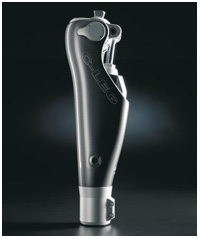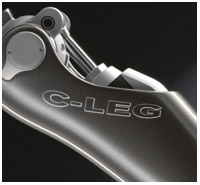C-Leg Microprocessor Prosthetic Knee
Stability right when you need it! With the C-Leg® and Compact knees you can speed up, slow down, take on hills and go down stairs step-over-step.
With the C-Leg® and Compact knees you can speed up, slow down, take on hills and go down stairs step-over-step.
You get unparalleled stability right when you need it—along with a secure, more natural gait.
How C-Leg technology works:
The revolutionary microprocessor that controls the C-Leg and Compact knees receives feedback from multiple sensors multiple times a second,allowing the knee to anticipate your next move and make adjustments in real-time. This keeps your knee stable when you need it, free-swinging when you step through—and always ready to support you if you stumble.
1 Pyramid Adapter
The pyramid adapter connects the C-Leg® or Compact to the prosthetic socket.
For people with knee disarticulation limb loss or those with especially long residual limbs, a threaded connector is also available.
2 Electronics
Algorithms based on thousands of gait cycles are built into our software.
The software considers the real‑time sensor data, and then establishes which phase of gait the user is in to determine the best resistance and setting.
3 Lithium-Ion Battery
Lithium-Ion battery provides users 40 – 45 hours of power.
4 Knee Angle Sensor The knee angle sensor constantly measures the flexion angle and the angular speed of the joint.
The knee angle sensor constantly measures the flexion angle and the angular speed of the joint.
It supplies the microprocessor with necessary information for dynamic control during swing phase and stability during stance phase.
5 Hydraulic Cylinder
A linear hydraulic cylinder controls the motion of the C-Leg and Compact.
It generates the appropriate level of resistance for flexion and extension during stance and swing phase, giving the user the support they need, right when they need it.
6 Carbon Fiber Frame
To withstand the demands of everyday life, the frame is constructed from carbon fiber, making it lightweight and incredibly strong.
The frame houses and protects the electronics, the hydraulic unit and the battery.
7 Tube Adapter with Moment Sensor
A moment sensor located in the tube adapter measures ankle movement from heel-strike to toeoff and lets the microprocessor know just where the user is in the gait cycle.

